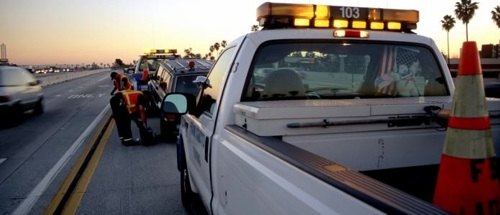Editorial: The Importance of Being Stranded
In general, today’s cars don’t put us in mortal peril (by themselves) or strand us miles from home. They don’t require any special driving or mechanical skills. As always, progress has come at a cost: it’s eliminated the character-building experiences that helped guys of my g-g-g-generation become “car guys.” Yup, I come from a time without cell phones, GPS navigation, OnStar, and vehicles that can breeze through 100,000 miles with little to no fear of meltdown. A time when cars offered a shorter shelf but more human – machine interaction. When car guys could look under the hood, see a problem and correct it. On the spot. I’m not bragging, so don’t put me down. Not yet, anyway.
Over the years, many a car has left me on the side of the road. I’ve seen blown up u-joints, water pumps, transmissions, alternators and starters. I’ve been in cars with busted clutches and blown gaskets. In fact, I’ve encountered failure in pretty much every component between the front bumper and the rear bumper. Few of these experiences were accompanied by a standard-issue warm and fuzzy Walt Disney ending—unless you include Bambi and Old Yeller in the mix. But they were all powerfully instructive experiences (the movies, too).
Today’s cell phone-wielding, speed-dialing AAA members will have no idea what I’m talking about. In the olden days, a breakdown mandated an immediate, hands-on mechanical inspection. Check belts, hoses, electrical connections, etc. Look for missing pieces. Listen for strange sounds. Check for puddles. Find a tool. Adjust, tinker, experiment. Pray. Repeat.
I view some of my unscheduled roadside pit-stops as impromptu shop class. For example, I learned that’s it always advisable to grease wheel bearings when I first heard the god-awful sound of a wheel bearing dying a horrible death on my way home. The same experience taught me that extreme heat makes for a great weld on parts that shouldn’t actually be welded together.
I repeat: living in a world without the luxury of dependable cavalry, malfunctions taught me to think on my feet. And how to drive.
I once had a charging problem on a busy highway at 2AM in the morning. There were exactly two solutions to this dilemma: pull on the headlights and listen to the sound of a car in mid-stall or leave the headlights off and continue the journey.
As a teenager ninety miles from home after eight hours on the road, the choice was easy (if monumentally foolish). I kept going. I tucked in behind a semi and followed his clearance lights. The trucker was an unwilling Good Samaritan; he flicked his rear lights continuously for the first 50 miles. But eventually he gave up and got on with the program. I never met the guy, but we shared one of those life-affirming moments despite his obvious initial blind terror. 10-4, good buddy.
Now that the statute of limitations has passed, I also admit piloting a brakeless car home. I wouldn’t recommend this kind of driving to anybody, but it does train you to look down the road a lot further than the average kid with a working set of brakes.
Of course, most of my roadside education was preventable. If I’d bought into the concept of the most basic maintenance, I’d have spent less time swearing at cars, skinning my knuckles and praising the Lord when my journey continued. But let’s face it; planning ahead is a rare part of any teenager’s game plan. At least not in the non-geek component of a high school environment where most of us desperately wanted to live.
Like all kids at my age, I learned everything the hard way—including the time I found out that a 1962 Volvo may look like a VW Beetle, but it doesn’t float like one. I had a 17-year-old’s less than stellar grasp of the legal implications of his daredevil behavior and wasn’t afraid not to use it.
Fast forward and we’ve arrived in a new era, where kids negotiate the Nürburgring in the comfort of their parent’s living rooms, without once worrying about flat tires, carburetor failure, fan belts breaking, etc. And when they take to the road, they can do so with the same ignorance and insouciance.
You could say that engineering excellence has sucked the life blood out of the automotive experience. Sure, today’s cars are remarkably easy to drive. Joe Consumer no longer has to calculate his chances of getting there from here, or acquire skills to raise the odds. But we’ve lost that hands-on spirit of adventure. Plastic engine covers and restrictive warranties deflect amateur interest. A significant percentage of problems are electronic, for which a wrench is less useful than package of Hamburger Helper.
I’m not saying that the average motorist yearns for a return to the days of “car trouble” and a reasonable chance of fixing it. I’m just saying that I am.
[For more of Jim Sutherland’s work, please visit mystarcollectorcar.com]
More by Jim Sutherland
Latest Car Reviews
Read moreLatest Product Reviews
Read moreRecent Comments
- Akila Hello Everyone, I found your blog very informative. If you want to know more about [url=
- Michael Gallagher I agree to a certain extent but I go back to the car SUV transition. People began to buy SUVs because they were supposedly safer because of their larger size when pitted against a regular car. As more SUVs crowded the road that safety advantage began to dwindle as it became more likely to hit an equally sized SUV. Now there is no safety advantage at all.
- Probert The new EV9 is even bigger - a true monument of a personal transportation device. Not my thing, but credit where credit is due - impressive. The interior is bigger than my house and much nicer with 2 rows of lounge seats and 3rd for the plebes. 0-60 in 4.5 seconds, around 300miles of range, and an e-mpg of 80 (90 for the 2wd). What a world.
- Ajla "Like showroom" is a lame description but he seems negotiable on the price and at least from what the two pictures show I've dealt with worse. But, I'm not interested in something with the Devil's configuration.
- Tassos Jong-iL I really like the C-Class, it reminds me of some trips to Russia to visit Dear Friend VladdyPoo.


































Comments
Join the conversation
I've been driving Toyotas since the 1969 Corona I had in high school. Apologies, but I've just never had any of this "broken down on the side of the road" business. And that's a big part of why I continue to buy Toyotas.
Points and old school distributors rewarded me many hours of timing adjustments and installing electronic point-preservers. It's good not to have to fool around with that any more. But maintenance remains important. You still have filters to clean, fluids to check/change, etc. Yourself, or a qualified technician can do those. Ignoring those basics will eventually result in an undriveable or severely damaged vehicle. Service techs I know have told me they get customers who have not changed oil in +10 K miles, then wondered why their engines were ruined.